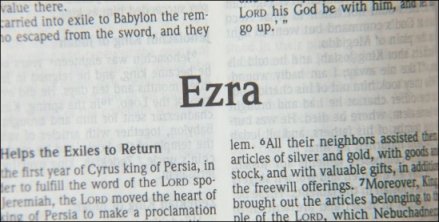
UNIVERSALISM
ii. NCAY ADDENDUM ON EZRA

Though no book in the Tanakh (Old Testament) supports a doctrine of eternal hell/torment/damnation, including the canonical Book of Ezra, the author makes reference to 'Ezra' as lending support to the doctrine, and it is important for the reader to understand that reference is being made to the whole collection of texts that use the scribe's name, of which only one is authentic (the Book of Ezra), the remainder being much later apocryphal or pseudepigraphical writings. As these are labelled rather differenly in the Hebrew, Aramaic, Greek, Latin and English traditions, a table has been compiled (below) to identify and distinguish them:
| English Bible Versions |
Greek Septuagint (LXX) |
Latin Vulgate |
Original Language |
| Ezra* Nehemiah* |
Esdras b* |
I Esdras* II Esdras* |
Hebrew & Aramaic* (in the Hebrew Bible, Ezra & Nehemiah are treated as one book, called the Book of Ezra) |
| 1 Esdras |
Esdras a |
III Esdras |
Greek |
| 2 Esdras |
(no equivalent) |
IV Esdras (sometimes subdivided further, with Ch.3-14 being known as 4 Ezra, Ch.1-2 as 5 Ezra & Ch.15-16 as 6 Ezra) |
Hebrew (lost - only known from the Latin &c.) |
The canonical (authorised, authentic) books are marked with an asterisk (*). References to eternal hell, being a later development caused by the influence of paganism (e.g. during the Babylonian exile), belong only to the apocryphal/pseudepigraphical works which are not marked with an asterisk (*). The reader should therefore treat with extreme caution those texts known in the English as 1 and 2 Esdras, in the Greek as Esdras a, and in the Latin as III and IV Esdras (also sometimes known as Esdras 4, 5 & 6). 'Esdras' is the Greek equivalent of the Hebrew 'Ezra'.
The principle repository of the doctrine of eternal torment of apocryphal and pseudepigraphical 'Ezra' is 2 Esdras (7:73ff.), itself three different works-in-one, and all of them far removed from the historical Ezra:
- 1. A 2nd century AD Christian prophecy and apocalypse about Yahweh's rejection of Israel and its replacement by the church (ch.1-2 = '5 Ezra');
- 2. A late 1st century AD Jewish apocalypse that explores the theological significance of the destruction of the temple of Jerusalem in 70 AD (ch.3-14 = '4 Ezra'); and
- 3. A 3rd century AD Christian prophecy and apocalypse intended to console and confirm the people of Elohim (God) in the midst of persecution (ch.15-16, '6 Ezra')
The composite text appears in the Slavonic Bible as '3 Esdras' and is customarily printed as '4 Esdras' in the Latin Vulgate but is not among the list of Roman Catholic canonical books approved by the Council of Trent. It is not regarded as canonical by Jews, Protestants, Messianics or most Orthodox Christians. Whilst the text gives us historical insights into the doctrines believed by Second Temple Judaism, it cannot be said to be inspired: there are several authors who contradict themselves.
Acknowledgements
[1] R.J.Coggins & M.A.Knibb, The Cambridge Bible Commentary, The First and Second Books of Esdras (Cambridge University Press, London: 1979)
[2] Daniel J. Harrington, The New Interpreter's Study Bible - New Revised Standard Version with Apocrypha, 2 Esdras (Abingdon Press, Nashville, Tennessee: 2003), pp.1677-1724
[3] Ed. R.H.Charles, The Apocrypha & Pseudepigrapha of the Old Testament in English, Volume 1, Apocrypha, 1 Esdras (OUP: 1976), pp.1-58



|


